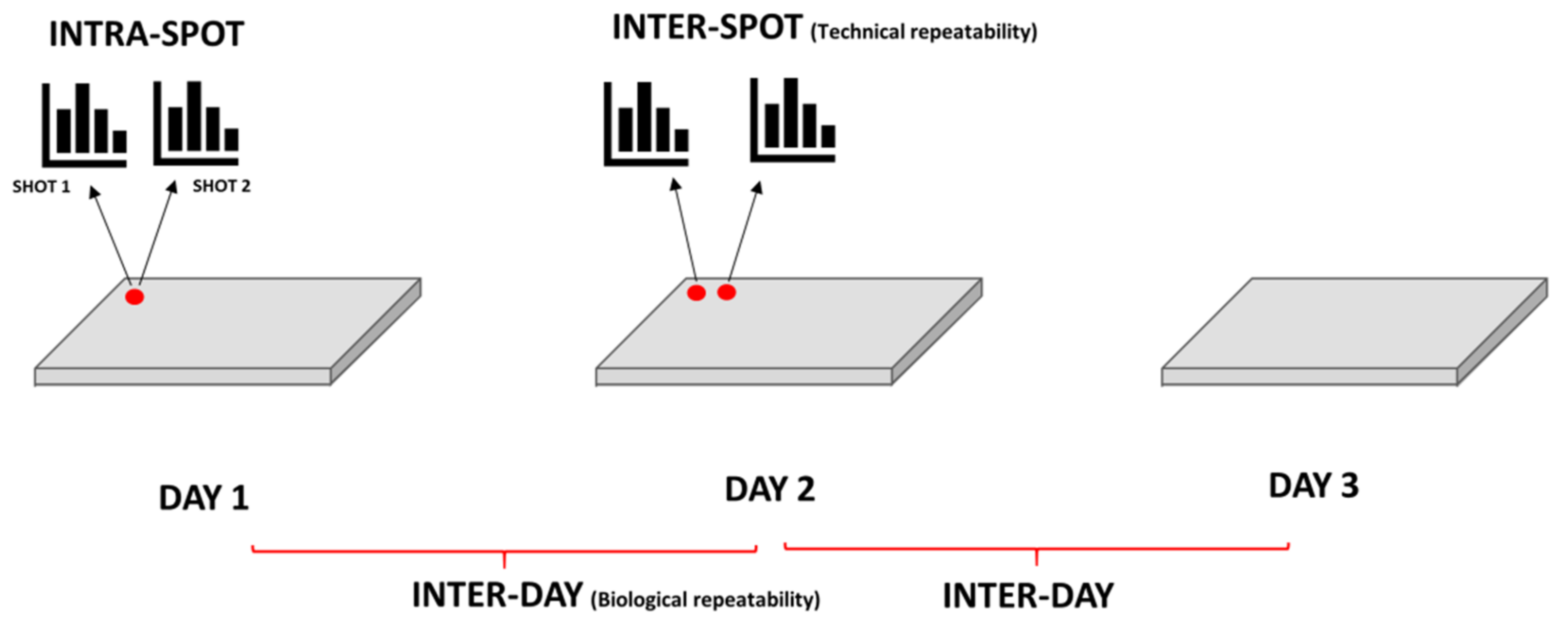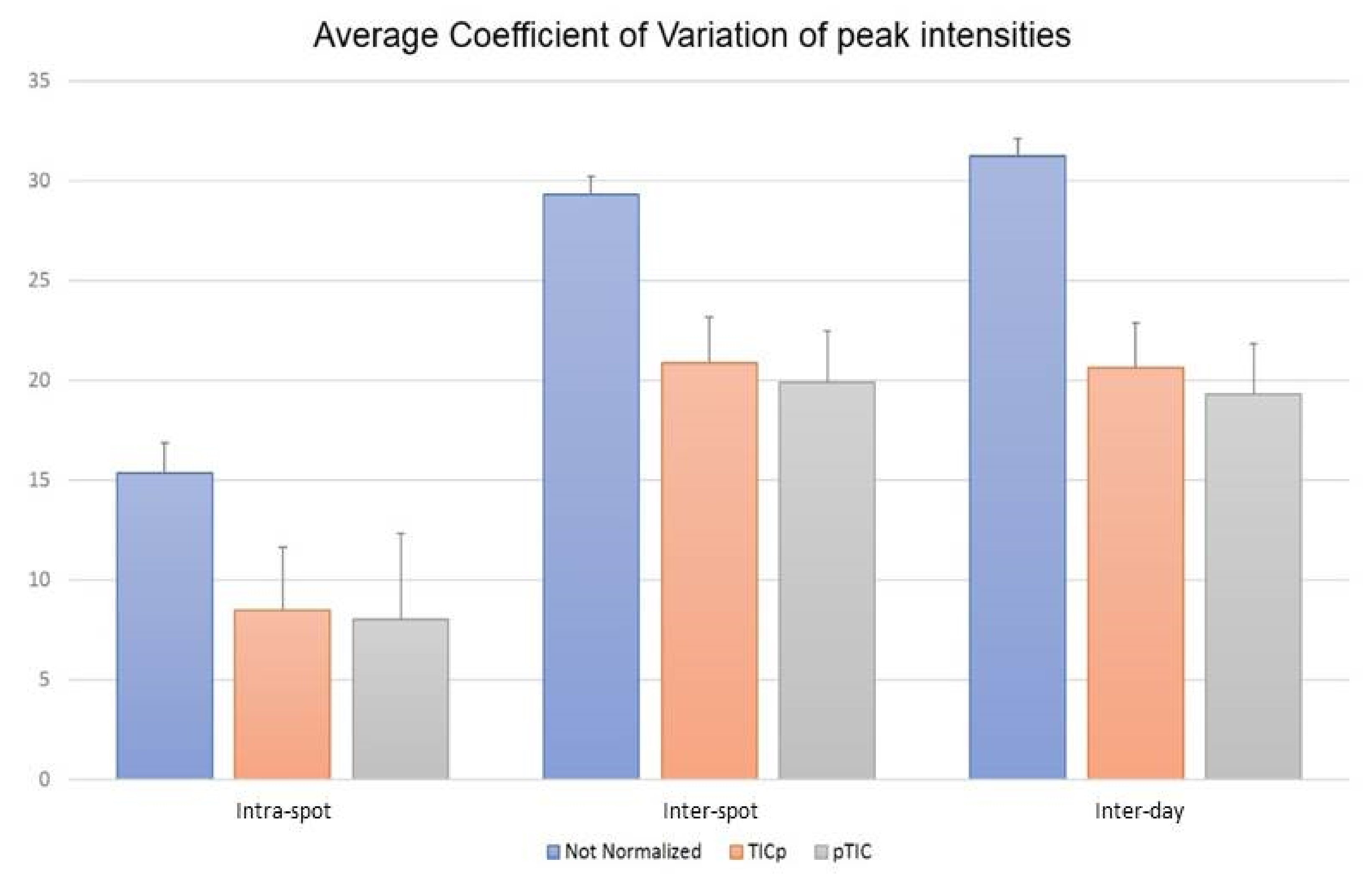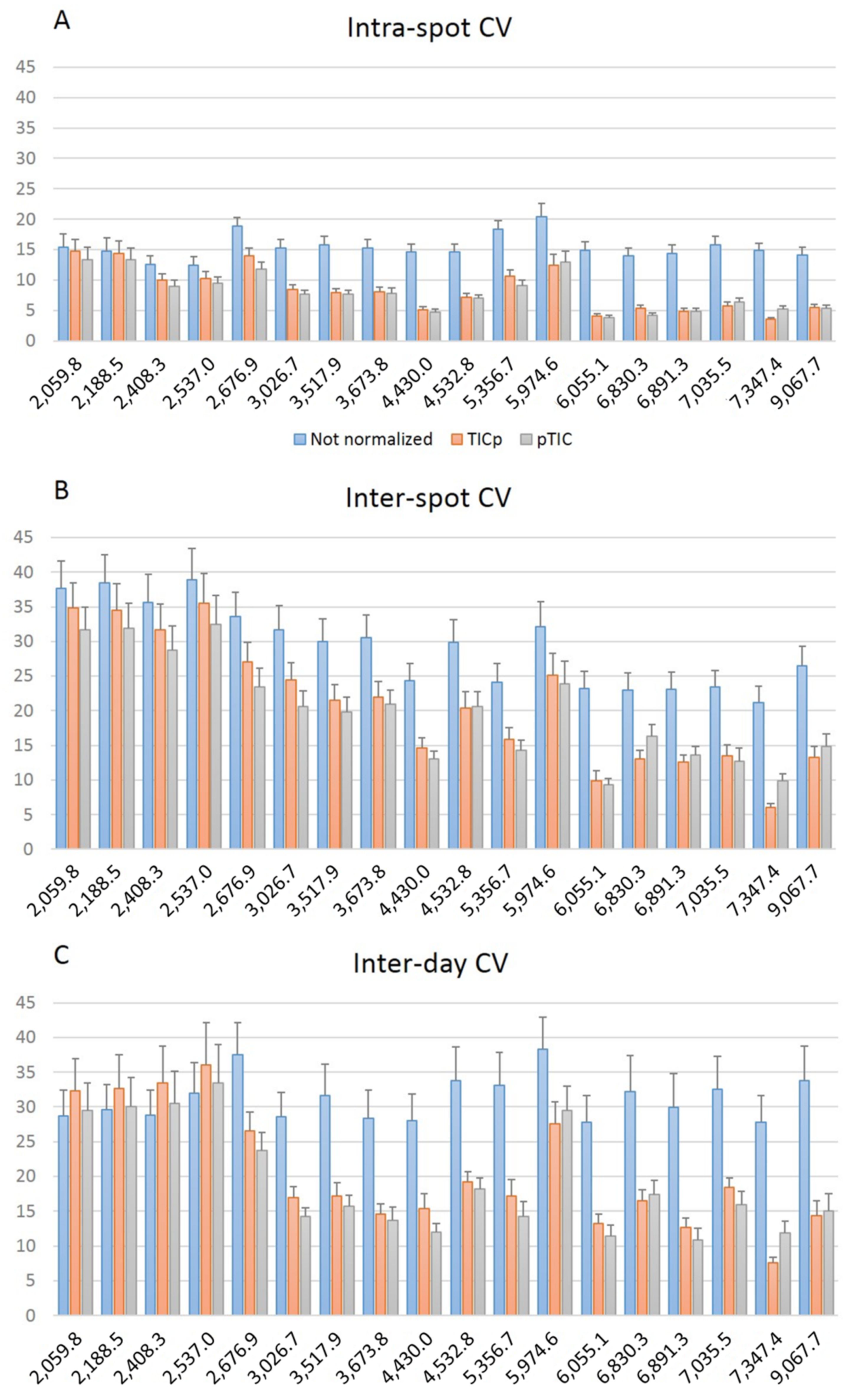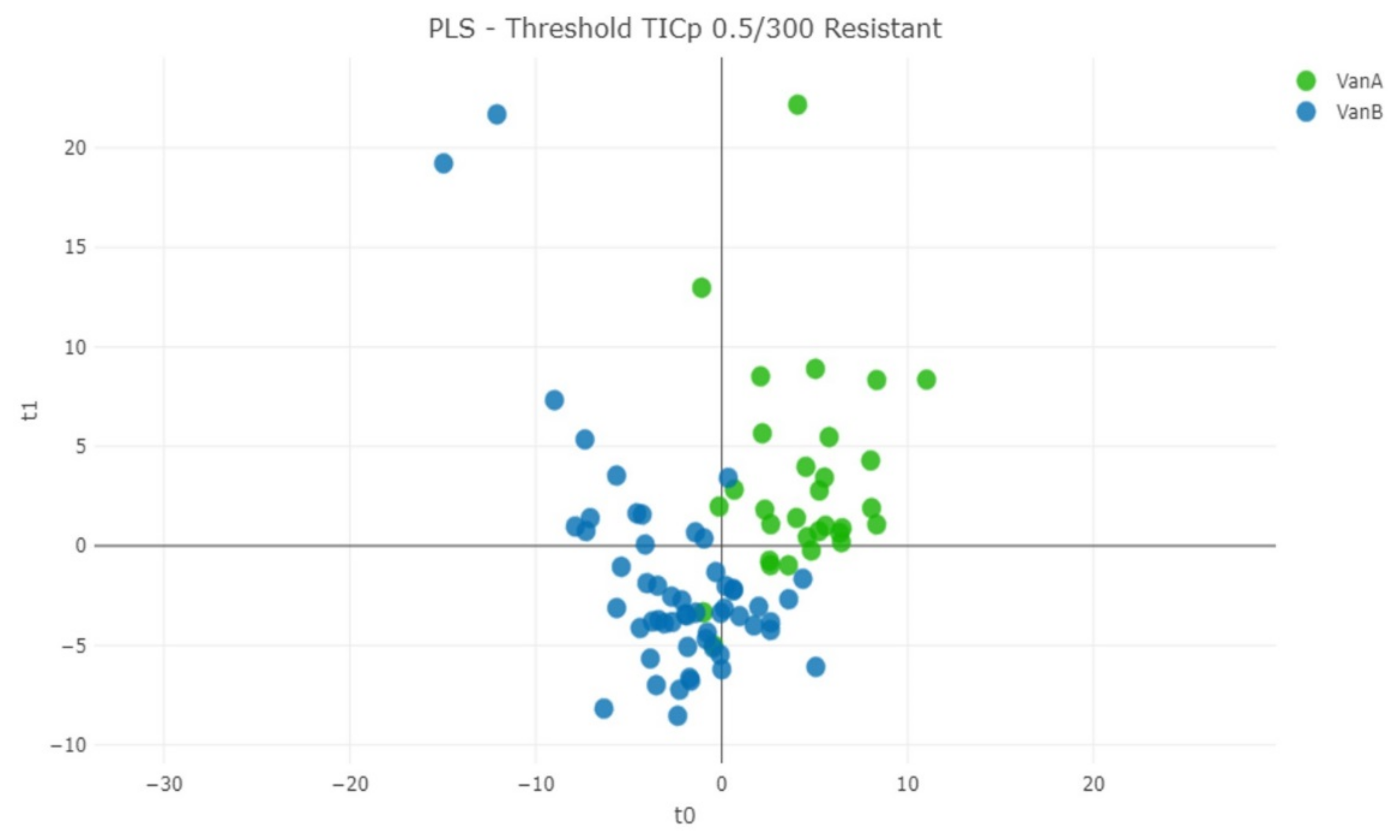Rapid and Reproducible MALDI-TOF-Based Method for the Detection of Vancomycin-Resistant Enterococcus faecium Using Classifying Algorithms
Abstract
1. Introduction
2. Materials and Methods
2.1. Bacterial Strains
2.2. Antibiotic Susceptibility Testing for Vancomycin
2.3. Identification of the Isolates by MALDI-TOF MS
2.4. Spectra Acquisition and Pre-Processing
2.5. Repeatability Test
2.6. Classification of E. faecium Isolates Based on Their MALDI-TOF MS Protein Spectra
3. Results
3.1. Identification by MALDI-TOF MS
3.2. Repeatability Study
3.3. Classification of the Isolates Using Machine Learning
4. Discussion
5. Conclusions
Supplementary Materials
Author Contributions
Funding
Institutional Review Board Statement
Informed Consent Statement
Data Availability Statement
Acknowledgments
Conflicts of Interest
Correction Statement
References
- Vu, J.; Carvalho, J. Enterococcus: Review of its physiology, pathogenesis, diseases and the challenges it poses for clinical microbiology. Front. Biol. 2011, 6, 357–366. [Google Scholar] [CrossRef]
- Arias, C.A.; Murray, B.E. The rise of the Enterococcus: Beyond vancomycin resistance. Nat. Rev. Microbiol. 2012, 10, 266–278. [Google Scholar] [CrossRef] [PubMed]
- Cattoir, V.; Leclercq, R. Twenty-five years of shared life with vancomycin-resistant enterococci: Is it time to divorce? J. Antimicrob. Chemother. 2013, 68, 731–742. [Google Scholar] [CrossRef] [PubMed]
- Miller, W.R.; Murray, B.E.; Rice, L.B.; Arias, C.A. Resistance in Vancomycin-Resistant Enterococci. Infect. Dis. Clin. N. Am. 2020, 34, 751–771. [Google Scholar] [CrossRef]
- Cattoir, V.; Giard, J.C. Antibiotic resistance in Enterococcus faecium clinical isolates. Expert Rev. Anti-Infect. Ther. 2014, 12, 239–248. [Google Scholar] [CrossRef]
- Rice, L.B. Federal funding for the study of antimicrobial resistance in nosocomial pathogens: No ESKAPE. J. Infect. Dis. 2008, 197, 1079–1081. [Google Scholar] [CrossRef]
- Chiang, H.Y.; Perencevich, E.N.; Nair, R.; Nelson, R.E.; Samore, M.; Khader, K.; Chorazy, M.L.; Herwaldt, L.A.; Blevins, A.; Ward, M.A.; et al. Incidence and Outcomes Associated with Infections Caused by Vancomycin-Resistant Enterococci in the United States: Systematic Literature Review and Meta-Analysis. Infect. Control Hosp. Epidemiol. 2017, 38, 203–215. [Google Scholar] [CrossRef]
- Lopez, M.; Cercenado, E.; Tenorio, C.; Ruiz-Larrea, F.; Torres, C. Diversity of clones and genotypes among vancomycin-resistant clinical Enterococcus isolates recovered in a Spanish hospital. Microb. Drug Resist. 2012, 18, 484–491. [Google Scholar] [CrossRef]
- Mirzaei, B.; Farivar, T.N.; Juhari, P.; Mehr, M.A.; Babaei, R. Investigation of the Prevalence of vanA and vanB genes in vancomycin resistant enterococcus (VRE) by Taq Man real time PCR Assay. J. Microbiol. Infect. Dis. 2013, 3, 192. [Google Scholar] [CrossRef]
- Hricová, K.; Štosová, T.; Kučová, P.; Fišerová, K.; Bardoň, J.; Kolář, M. Analysis of Vancomycin-Resistant Enterococci in Hemato-Oncological Patients. Antibiotics 2020, 9, 785. [Google Scholar] [CrossRef]
- Seng, P.; Drancourt, M.; Gouriet, F.; La Scola, B.; Fournier, P.E.; Rolain, J.M.; Raoult, D. Ongoing revolution in bacteriology: Routine identification of bacteria by matrix-assisted laser desorption ionization time-of-flight mass spectrometry. Clin. Infect. Dis. Off. Publ. Infect. Dis. Soc. Am. 2009, 49, 543–551. [Google Scholar] [CrossRef]
- Oviaño, M.; Gómara, M.; Barba, M.J.; Revillo, M.J.; Barbeyto, L.P.; Bou, G. Towards the early detection of beta-lactamase-producing Enterobacteriaceae by MALDI-TOF MS analysis. J. Antimicrob. Chemother. 2017, 72, 2259–2262. [Google Scholar] [CrossRef] [PubMed]
- Schuster, D.; Josten, M.; Janssen, K.; Bodenstein, I.; Albert, C.; Schallenberg, A.; Gajdiss, M.; Sib, E.; Szekat, C.; Kehl, K.; et al. Detection of methicillin-resistant coagulase-negative staphylococci harboring the class A mec complex by MALDI-TOF mass spectrometry. Int. J. Med. Microbiol. 2018, 308, 522–526. [Google Scholar] [CrossRef] [PubMed]
- Oviano, M.; Bou, G. Matrix-Assisted Laser Desorption Ionization-Time of Flight Mass Spectrometry for the Rapid Detection of Antimicrobial Resistance Mechanisms and Beyond. Clin. Microbiol. Rev. 2019, 32, 927–937. [Google Scholar]
- Rodriguez-Sanchez, B.; Cercenado, E.; Coste, A.T.; Greub, G. Review of the impact of MALDI-TOF MS in public health and hospital hygiene, 2018. Eurosurveillance 2019, 24, 1800193. [Google Scholar] [CrossRef] [PubMed]
- Lasch, P.; Fleige, C.; Stämmler, M.; Layer, F.; Nübel, U.; Witte, W.; Werner, G. Insufficient discriminatory power of MALDI-TOF mass spectrometry for typing of Enterococcus faecium and Staphylococcus aureus isolates. J. Microbiol. Methods 2014, 100, 58–69. [Google Scholar] [CrossRef]
- Freitas, A.R.; Sousa, C.; Novais, C.; Silva, L.; Ramos, H.; Coque, T.M.; Lopes, J.; Peixe, L. Rapid detection of high-risk Enterococcus faecium clones by matrix-assisted laser desorption ionization time-of-flight mass spectrometry. Diagn. Microbiol. Infect. Dis. 2017, 87, 299–307. [Google Scholar] [CrossRef]
- Holzknecht, B.J.; Dargis, R.; Pedersen, M.; Pinholt, M.; Christensen, J.J.; Hammerum, A.M.; Littauer, P.; Worning, P.; Westh, H.; Moser, C.; et al. Typing of vancomycin-resistant enterococci with MALDI-TOF mass spectrometry in a nosocomial outbreak setting. Clin. Microbiol. Infect. Off. Publ. Eur. Soc. Clin. Microbiol. Infect. Dis. 2018, 24, 1104.e1–1104.e4. [Google Scholar] [CrossRef] [PubMed]
- Rodriguez-Sanchez, B.; Marín, M.; Sánchez-Carrillo, C.; Cercenado, E.; Ruiz, A.; Rodríguez-Créixems, M.; Bouza, E. Improvement of matrix-assisted laser desorption/ionization time-of-flight mass spectrometry identification of difficult-to-identify bacteria and its impact in the workflow of a clinical microbiology laboratory. Diagn. Microbiol. Infect. Dis. 2014, 79, 1–6. [Google Scholar] [CrossRef] [PubMed]
- Oberle, M.; Wohlwend, N.; Jonas, D.; Maurer, F.P.; Jost, G.; Tschudin-Sutter, S.; Vranckx, K.; Egli, A. The Technical and Biological Reproducibility of Matrix-Assisted Laser Desorption Ionization-Time of Flight Mass Spectrometry (MALDI-TOF MS) Based Typing: Employment of Bioinformatics in a Multicenter Study. PLoS ONE 2016, 11, e0164260. [Google Scholar] [CrossRef]
- Quintela-Baluja, M.; Böhme, K.; Fernández-No, I.C.; Morandi, S.; Alnakip, M.E.; Caamaño-Antelo, S.; Barros-Velázquez, J.; Calo-Mata, P. Characterization of different food-isolated Enterococcus strains by MALDI-TOF mass fingerprinting. Electrophoresis 2013, 34, 2240–2250. [Google Scholar] [CrossRef] [PubMed]
- Zvezdanova, M.E.; Arroyo, M.J.; Méndez, G.; Guinea, J.; Mancera, L.; Muñoz, P.; Rodríguez-Sánchez, B.; Escribano, P. Implementation of MALDI-TOF Mass Spectrometry and Peak Analysis: Application to the Discrimination of Cryptococcus neoformans Species Complex and Their Interspecies Hybrids. J. Fungi 2020, 6, 330. [Google Scholar] [CrossRef] [PubMed]
- Weis, C.V.; Jutzeler, C.R.; Borgwardt, K. Machine learning for microbial identification and antimicrobial susceptibility testing on MALDI-TOF mass spectra: A systematic review. Clin. Microbiol. Infect. Off. Publ. Eur. Soc. Clin. Microbiol. Infect. Dis. 2020, 26, 1310–1317. [Google Scholar] [CrossRef] [PubMed]
- Timm, W.; Scherbart, A.; Bocker, S.; Kohlbacher, O.; Nattkemper, T.W. Peak intensity prediction in MALDI-TOF mass spectrometry: A machine learning study to support quantitative proteomics. BMC Bioinform. 2008, 9, 443. [Google Scholar] [CrossRef] [PubMed]
- Griffin, P.M.; Price, G.R.; Schooneveldt, J.M.; Schlebusch, S.; Tilse, M.H.; Urbanski, T.; Hamilton, B.; Venter, D. Use of matrix-assisted laser desorption ionization-time of flight mass spectrometry to identify vancomycin-resistant enterococci and investigate the epidemiology of an outbreak. J. Clin. Microbiol. 2012, 50, 2918–2931. [Google Scholar] [CrossRef]
- Brackmann, M.; Leib, S.L.; Tonolla, M.; Schurch, N.; Wittwer, M. Antimicrobial resistance classification using MALDI-TOF-MS is not that easy: Lessons from vancomycin-resistant Enterococcus faecium. Clin. Microbiol. Infect. Off. Publ. Eur. Soc. Clin. Microbiol. Infect. Dis. 2020, 26, 391–393. [Google Scholar] [CrossRef]
- Nakano, S.; Matsumura, Y.; Kato, K.; Yunoki, T.; Hotta, G.; Noguchi, T.; Yamamoto, M.; Nagao, M.; Ito, Y.; Takakura, S.; et al. Differentiation of vanA-positive Enterococcus faecium from vanA-negative E. faecium by matrix-assisted laser desorption/ionisation time-of-flight mass spectrometry. Int. J. Antimicrob. Agents 2014, 44, 256–259. [Google Scholar] [CrossRef]
- Pang, R.T.; Johnson, P.J.; Chan, C.M.; Kong, E.K.; Chan, A.T.; Sung, J.J.; Poon, T.C. Technical evaluation of MALDI-TOF mass spectrometry for quantitative proteomic profiling matrix formulation and application. Clin. Proteom. J. 2004, 1, 12. [Google Scholar] [CrossRef][Green Version]





| Mass (m/z) | Measurements | ||
|---|---|---|---|
| Appearance (%) | CV (%) | Mean | |
| 2059.79 | 178/178 (100) | 53.42 | 4361.20 |
| 2188.53 | 178/178 (100) | 56.61 | 5269.55 |
| 2408.35 | 178/178 (100) | 49.04 | 3316.45 |
| 2537.05 | 178/178 (100) | 53.06 | 3527.45 |
| 2676.89 | 178/178 (100) | 51.89 | 2170.47 |
| 3026.71 | 178/178 (100) | 47.65 | 1270.16 |
| 3517.85 | 178/178 (100) | 56.14 | 1327.19 |
| 3673.77 | 178/178 (100) | 50.43 | 3344.71 |
| 4430.01 | 178/178 (100) | 46.26 | 17,437.72 |
| 4532.78 | 178/178 (100) | 57.94 | 2296.61 |
| 5356.72 | 178/178 (100) | 56.15 | 8719.83 |
| 5974.65 | 178/178 (100) | 68.28 | 2531.38 |
| 6055.07 | 178/178 (100) | 50.30 | 4187.74 |
| 6830.35 | 178/178 (100) | 71.56 | 3020.35 |
| 6891.33 | 178/178 (100) | 59.00 | 5252.80 |
| 7035.47 | 178/178 (100) | 65.96 | 2656.59 |
| 7347.39 | 178/178 (100) | 55.31 | 10,326.29 |
| 9062.75 | 178/178 (100) | 66.94 | 2820.45 |
| Not Normalized | TICp | pTIC | ||||
|---|---|---|---|---|---|---|
| Arithmetic | Post-Alignment | Arithmetic | Post-Alignment | Arithmetic | Post-Alignment | |
| Inter-spot mean | 3825.44 | 3792.14 | 0.0005 | 0.0005 | 0.056 | 0.056 |
| Inter-day mean | 3974.07 | 3955.49 | 0.0005 | 0.0005 | 0.056 | 0.056 |
| Actual Classification | Predicted Classification | |
|---|---|---|
| (A) SVM Full Spectrum | VRE | VSE |
| VRE | 70 | 16 |
| VSE | 18 | 74 |
| (B) PLS Threshold TICp | VanA | VanB |
| VanA | 25 | 6 |
| VanB | 6 | 49 |
| Peak m/z | AUC (≥0.8) | Appearance (Total Samples) | Positive Category | Coefficient of Variation (CV) |
|---|---|---|---|---|
| 5095.01 | 0.814 | 123/178 | 82/86 (resistant) | 61.63% |
Publisher’s Note: MDPI stays neutral with regard to jurisdictional claims in published maps and institutional affiliations. |
© 2022 by the authors. Licensee MDPI, Basel, Switzerland. This article is an open access article distributed under the terms and conditions of the Creative Commons Attribution (CC BY) license (https://creativecommons.org/licenses/by/4.0/).
Share and Cite
Candela, A.; Arroyo, M.J.; Sánchez-Molleda, Á.; Méndez, G.; Quiroga, L.; Ruiz, A.; Cercenado, E.; Marín, M.; Muñoz, P.; Mancera, L.; et al. Rapid and Reproducible MALDI-TOF-Based Method for the Detection of Vancomycin-Resistant Enterococcus faecium Using Classifying Algorithms. Diagnostics 2022, 12, 328. https://doi.org/10.3390/diagnostics12020328
Candela A, Arroyo MJ, Sánchez-Molleda Á, Méndez G, Quiroga L, Ruiz A, Cercenado E, Marín M, Muñoz P, Mancera L, et al. Rapid and Reproducible MALDI-TOF-Based Method for the Detection of Vancomycin-Resistant Enterococcus faecium Using Classifying Algorithms. Diagnostics. 2022; 12(2):328. https://doi.org/10.3390/diagnostics12020328
Chicago/Turabian StyleCandela, Ana, Manuel J. Arroyo, Ángela Sánchez-Molleda, Gema Méndez, Lidia Quiroga, Adrián Ruiz, Emilia Cercenado, Mercedes Marín, Patricia Muñoz, Luis Mancera, and et al. 2022. "Rapid and Reproducible MALDI-TOF-Based Method for the Detection of Vancomycin-Resistant Enterococcus faecium Using Classifying Algorithms" Diagnostics 12, no. 2: 328. https://doi.org/10.3390/diagnostics12020328
APA StyleCandela, A., Arroyo, M. J., Sánchez-Molleda, Á., Méndez, G., Quiroga, L., Ruiz, A., Cercenado, E., Marín, M., Muñoz, P., Mancera, L., Rodríguez-Temporal, D., & Rodríguez-Sánchez, B. (2022). Rapid and Reproducible MALDI-TOF-Based Method for the Detection of Vancomycin-Resistant Enterococcus faecium Using Classifying Algorithms. Diagnostics, 12(2), 328. https://doi.org/10.3390/diagnostics12020328









